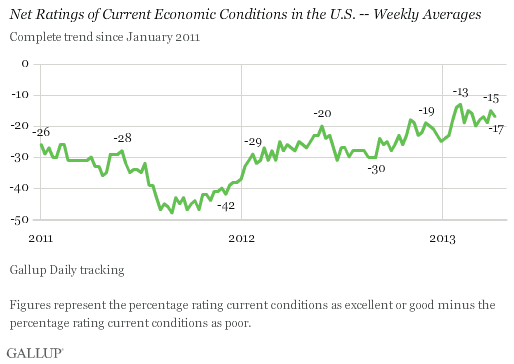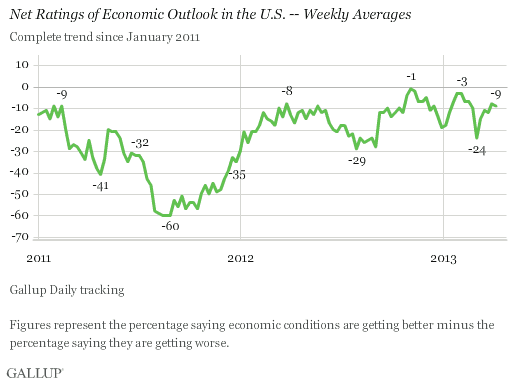WASHINGTON, D.C. -- Americans' confidence in the economy showed no change last week as the U.S. stock market's rally slowed. The Gallup Economic Confidence Index was -13 for the week ending April 7.

Americans have been relatively more confident in the economy this year than they have been throughout the last several years. Gallup's Economic Confidence Index started the year at -21 following the fiscal cliff negotiations but climbed to reach a five-year weekly high of -8 in early February. The Economic Confidence Index then fell sharply to -22 in early March after Congress and the president failed to reach a deal to avoid the budget sequestration spending cuts. The index registered improvements, however, for the following two weeks as the U.S. stock market reached record highs. Last week's score of -13 remains five points off the five-year weekly high.
Gallup's Economic Confidence Index is based on Americans' ratings of current economic conditions in the United States as well as their assessments of whether the economy is getting better or worse. It has a theoretical minimum of -100 and a theoretical maximum of +100. The index score has never been positive since Gallup began daily tracking of economic confidence in 2008.
Americans' perceptions of current economic conditions remain more negative than positive. The -17 current conditions rating recorded last week, based on 18% of Americans saying economic conditions are excellent or good and 35% saying they are poor, is on par with the current conditions rating of -15 the week prior.

Similarly, Americans' assessments of future economic conditions are more negative than positive. Forty-three percent of Americans now say the economy is getting better and 52% say it is getting worse, for a -9 economic outlook rating -- similar to the -8 recorded the previous week.

Bottom Line
Confidence in the economy remained unchanged last week as the U.S. stock market declined and the employment situation remained stagnant. Americans' economic confidence is now back to where it was in February, rebounding from the drop that occurred after Congress and the president failed to reach a deal to avert automatic federal spending cuts.
On a relative basis, Americans' confidence in the economy is about as high as it has been at any point in the last five years. There are obvious positive signs such as an improving housing market and an increase in consumer spending. Of course, threats to the economy remain, from the shaky jobs situation to the uncertainty concerning the federal budget. Gallup will continue to monitor U.S. economic confidence in the weeks and months ahead to see how these competing forces sort out in Americans' overall view of the current health of the economy.
Gallup.com reports results from these indexes in daily, weekly, and monthly averages and in Gallup.com stories. Complete trend data are always available to view and export in the following charts:
Daily: Employment, Economic Confidence, Job Creation, Consumer Spending
Weekly: Employment, Economic Confidence, Job Creation, Consumer Spending
Read more about Gallup's economic measures.
View our economic release schedule.
Survey Methods
Results for this Gallup poll are based on telephone interviews conducted April 1-7, 2013, on the Gallup Daily tracking survey, with a random sample of 3,553 adults, aged 18 and older, living in all 50 U.S. states and the District of Columbia.
For results based on the total sample of national adults, one can say with 95% confidence that the maximum margin of sampling error is ±2 percentage points.
Interviews are conducted with respondents on landline telephones and cellular phones, with interviews conducted in Spanish for respondents who are primarily Spanish-speaking. Each sample of national adults includes a minimum quota of 50% cellphone respondents and 50% landline respondents, with additional minimum quotas by region. Landline telephone numbers are chosen at random among listed telephone numbers. Cellphone numbers are selected using random-digit-dial methods. Landline respondents are chosen at random within each household on the basis of which member had the most recent birthday.
Samples are weighted to correct for unequal selection probability, nonresponse, and double coverage of landline and cell users in the two sampling frames. They are also weighted to match the national demographics of gender, age, race, Hispanic ethnicity, education, region, population density, and phone status (cellphone only/landline only/both, cellphone mostly, and having an unlisted landline number). Demographic weighting targets are based on the March 2012 Current Population Survey figures for the aged 18 and older U.S. population. Phone status targets are based on the July-December 2011 National Health Interview Survey. Population density targets are based on the 2010 census. All reported margins of sampling error include the computed design effects for weighting.
In addition to sampling error, question wording and practical difficulties in conducting surveys can introduce error or bias into the findings of public opinion polls.
For more details on Gallup's polling methodology, visit https://www.gallup.com/.
